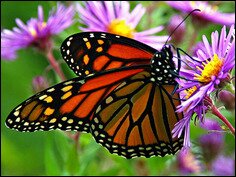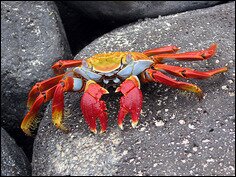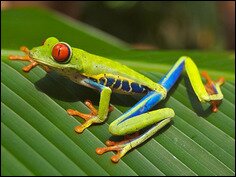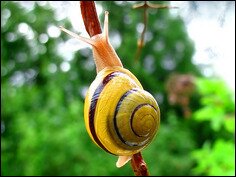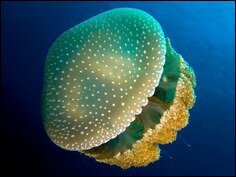What Is A Herbivore?
Posted In: Feeding Behavior.
The herbivore is an animal that eats plant materials such as plant fluids (sap), leaves, nectar, seeds, stems, bark, wood, fruits and flowers of plants. While a human being can digest plants, their anatomy and physiology is not one totally adapted to the digestion of only plant material. This puts human beings in another category altogether. They are omnivores, which means that they consume both, plants and animals. Herbivore is the other hand, has a digestive system specifically designed to break down plant material.
 82% of a Hoatzin’s diet is made up of leaves. It is an example of a folivore. © Kate from UK.
82% of a Hoatzin’s diet is made up of leaves. It is an example of a folivore. © Kate from UK.
Herbivores are very important
Plants that eat animals are a very important part of the food chain. Without plants and plant eating animals, many carnivores would die out. The animals that eat plants gain nutrition that the plants produce using the process called photosynthesis. These animals can survive eating only rough and fibrous plant matter, it is for this reason that herbivores are considered the primary consumers in the food chain.
Consumer-resource system
 Green Violetear. A hummingbird is example of a nectarivore. © Mdf.
Green Violetear. A hummingbird is example of a nectarivore. © Mdf.
In the study of the predator – prey interactions, we find that the relationship between plants and animals that eat them is more like a cycle. When there are lots of plants, the numbers of herbivores increase. As these animals begin to reduce the plant population, their numbers also decline. Carnivores, on the other hand, consumes herbivores. As the number of carnivores increase, the population of herbivores decrease. In this manner, nature has created its own form of checks and balances.
 TheʻIʻiwi (Vestiaria coccinea) is a nectarivore. © USFWS.
TheʻIʻiwi (Vestiaria coccinea) is a nectarivore. © USFWS.
Specialty eaters
It is impossible for the animals to completely wipe out a given variety of plant, they never find all of the pockets of plants. This is especially important because there are some herbivores that are specialty eaters. For instance, the giant panda only eats one type of bamboo. If their population grew unchecked, they could conceivably wipe out the bamboo species.
Specialized teeth
The evolutionary process has made some changes in the physiology of herbivores. Herbivores have teeth that are adapted to grind fibrous plant tissue. Their teeth are broad and flat, which makes it better to grind grasses, leaves and twigs.
 Pea aphids sucking sap from a plant. It is a mucivore. © Shipher Wu, National Taiwan University.
Pea aphids sucking sap from a plant. It is a mucivore. © Shipher Wu, National Taiwan University.
Specialized herbivores
Animals like horses, hippos, manatees and zebras are called grazers and they eat only grass. Other animals eat fruits or leaves and most of these animals can’t chew or digest meat. The followings are some specialized herbivores:
- Frugivore – Their diet consist mainly of fruits. Examples are like Ruffed lemur, Maned wolf, Cassowary, Orangutan, fruit bat and gray-bellied night monkey.
- Folivores – Their diet consist mainly of leaves. Examples are like koalas, sloths and the Hoatzin (a bird).
- Nectarivore – Their diet consist mainly of nectar. Examples are like Honey possums, hummingbirds, butterflies and hawk moths.
- Granivores – Their diet consist mainly of seeds. An examples is the Hawaiian honeycreeper.
- Palynivores – Their diet consist mainly of pollen. An example is the bee. Other species like butterflies, moths, beetles and flies may consume pollen but at different stages of their life cycle.
- Mucivore – Their diet consist mainly of plant fluids, sap. Examples include aphids and adult cicadas.
- Xylophagy – Their diet consist mainly of wood. Examples are termites, bark beetles, horntail (wood wasp), panague (a genus of armored catfishes), gribble, giant pandas and Shipworm (a saltwater clam, known as “termites of the sea”).
 A honey bee carrying pollen in a pollen basket. Bees are examples of palynivores. © Muhammad Mahdi Karim.
A honey bee carrying pollen in a pollen basket. Bees are examples of palynivores. © Muhammad Mahdi Karim.
Herbivores need help too
Plants are made up mostly of a substance known as cellulose. Herbivores rely on bacteria in their digestive tract to help to break this down. This is a prime example of a symbiotic relationship between the living organisms inside the animal and the animal itself. There are many people who don’t eat meat and live on a mainly vegetarian diet. This doesn’t make them herbivores. They are referred to as vegetarians.
There are more herbivores
 Termite worker, an example of xylophagy. © Althepal.
Termite worker, an example of xylophagy. © Althepal.
As long as the weather patterns hold, trees and plants grow in abundance. Herbivores have it easier than carnivores, when it comes to finding food. Plants don’t fight back and they don’t run. Although some plants have developed certain defenses against being eaten, such as spines, poisons or other toxins, that gives them a bad taste. It is then not a surprise to know that the herbivores outnumber carnivores.
Ruminants
Many herbivores belong to a group called ruminants. These mammals have four-compartment stomach, each aids in the digestion of the plant matter. Animals that are ruminants includes:
- Cattle
- Goats
- Sheep
- Giraffes
- Yaks
- Deer
- Camels
- llamas
- Antelope



